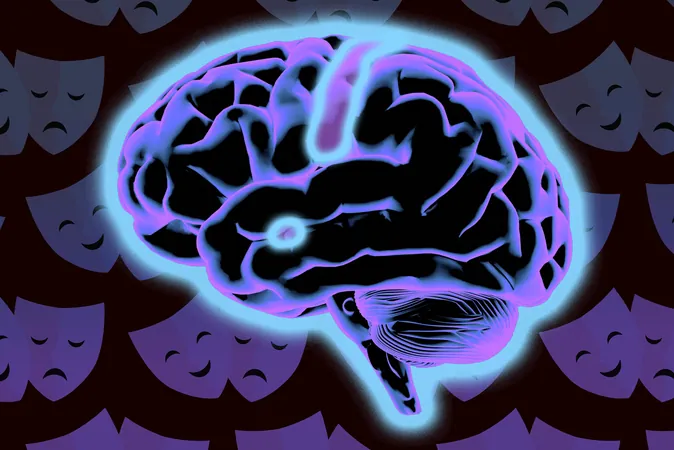
Immune Molecules: The Surprising Link Between Infection, Anxiety, and Sociability in the Brain
2025-04-07
Author: Sarah
Introduction
Recent research is unveiling a fascinating connection between the immune system and our behavior. Immune molecules known as cytokines are well-known for their roles in fighting infections and managing inflammation. However, exciting studies suggest that they also have profound effects on our brains, influencing everything from anxiety levels to social behaviors.
The Role of IL-17
Two groundbreaking studies from MIT and Harvard Medical School focus on a cytokine called IL-17, delving into its dual impact on the brain. The findings indicate that IL-17 acts on two pivotal brain regions: the amygdala, responsible for processing emotions like fear and anxiety, and the somatosensory cortex, which promotes sociable behaviors. Specifically, in the amygdala, IL-17 can trigger anxiety, while its action in the cortex encourages social interactions.
Linking Immune Response to Behavior
This intriguing relationship showcases the intricate connections between our immune and nervous systems, as highlighted by Gloria Choi, an MIT associate professor and a lead author of the studies. She explains that illness can significantly alter one's internal emotional and behavioral state, something that goes beyond mere physical fatigue.
Fever Effect and Neuronal Impact
The research team initially became interested in IL-17 after discovering its role in what is known as the "fever effect," a phenomenon noted in studies of autistic children whose behavioral symptoms often diminish during fever. Further investigations led to the revelation that IL-17 influences specific neurons in the brain, linking immune responses to alterations in behavior.
Variants and Receptor Mapping
Notably, IL-17 exists in six variants, each capable of binding to five different receptors. The researchers mapped these receptors in the brain, discovering that two particular receptors, IL-17RA and IL-17RB, are present in the somatosensory cortex, highlighting their role in behavioral regulation. When a variant known as IL-17E interacts with these receptors, it lowers neuronal excitability, which is potentially linked to mitigating certain behavioral symptoms.
Evolutionary Perspective
Choi proposes an evolutionary perspective—that some forms of IL-17 may have originally developed as neuromodulators before being appropriated for immune functions. This theory aligns with earlier studies on C. elegans, where IL-17 does not play an immune role but instead affects social behaviors.
Anxiety and Neuronal Excitability
In the amygdala, another study revealed that IL-17 receptors increase neuronal excitability, leading to heightened anxiety. Interestingly, blocking these receptors may paradoxically raise circulating levels of IL-17C, which opens a dialogue about potential adverse mental health effects in treatments targeting IL-17, particularly in conditions like psoriasis.
Evolutionary Benefits of Anxiety
The researchers speculate that increased anxiety during infections may serve an evolutionary purpose, encouraging individuals to avoid social interactions that could spread disease. Choi emphasizes the immune system's role in not just fighting pathogens but also guiding behaviors to protect both individuals and their communities.
Immune System and Anxiety Regulation
Interestingly, the same neuronal populations that respond to IL-17 also respond to IL-10, a cytokine that reduces inflammation, providing a mechanism for the body to regulate anxiety levels.
Conclusion
This comprehensive investigation illustrates that the immune system can exert diverse influences on brain function and behavior. "We've identified different receptor combinations in specific neurons across various brain regions influencing markedly differing behaviors," remarks Choi.
Future Research and Therapeutic Implications
Future research pursuits will delve deeper into the specificities of IL-17's interactions within the brain, with implications for understanding and treating neurological conditions like autism and depression. Choi proposes an innovative therapeutic angle: instead of directly targeting brain functions, manipulating the immune system could offer new pathways to influence mental health.
This research not only sheds light on the complex interplay between the immune system and brain functions but also opens exciting possibilities for therapeutic developments that target these interactions to better mental health outcomes. Stay tuned, as scientists continue to unravel these connections that may reshape our understanding of health and behavior!



 Brasil (PT)
Brasil (PT)
 Canada (EN)
Canada (EN)
 Chile (ES)
Chile (ES)
 Česko (CS)
Česko (CS)
 대한민국 (KO)
대한민국 (KO)
 España (ES)
España (ES)
 France (FR)
France (FR)
 Hong Kong (EN)
Hong Kong (EN)
 Italia (IT)
Italia (IT)
 日本 (JA)
日本 (JA)
 Magyarország (HU)
Magyarország (HU)
 Norge (NO)
Norge (NO)
 Polska (PL)
Polska (PL)
 Schweiz (DE)
Schweiz (DE)
 Singapore (EN)
Singapore (EN)
 Sverige (SV)
Sverige (SV)
 Suomi (FI)
Suomi (FI)
 Türkiye (TR)
Türkiye (TR)
 الإمارات العربية المتحدة (AR)
الإمارات العربية المتحدة (AR)